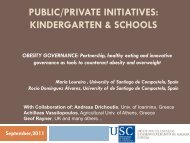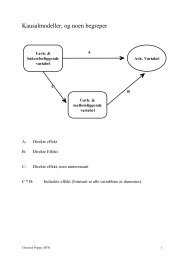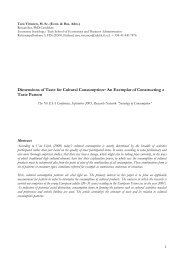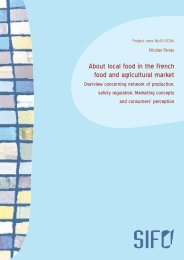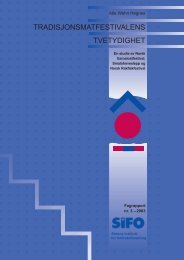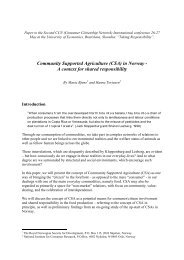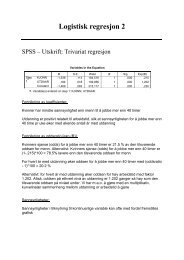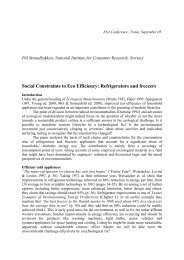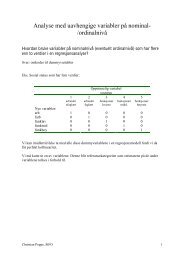Create successful ePaper yourself
Turn your PDF publications into a flip-book with our unique Google optimized e-Paper software.
Summary 11<br />
on New Year’s Eve. Pork ribs and ribs of mutton are the most popular pre-<br />
Christmas and Christmas Week dishes. Cod and lutefisk are far more popular<br />
as pre-Christmas and Christmas Week dishes than as Christmas Eve dishes.<br />
Lutefisk seems to be a typical example of a conspicuous status dish. The<br />
higher the income, the more likely you are to have eaten this in the period before<br />
Christmas.<br />
A relatively new and trendy pre-Christmas dish in Norway is the so-called<br />
”Christmas-tapas”. This is frequently described as ”Christmas food with a<br />
new twist”. Of the many countries that are represented in the Norwegian dinner<br />
culture, particularly the Mediterranean countries seem to have been particular<br />
trendsetters in recent decades (Bugge 2005, Bugge and Almås 2006).<br />
Choosing a slightly more modern form of pre-Christmas dishes may perhaps<br />
also be a solution to the dilemma: Is it ok to eat traditional Christmas food<br />
before Christmas or should you wait? Approxi<strong>mat</strong>ely 50 percent of the Norwegian<br />
population feel that one ”should wait”.<br />
With regard to the choice of New Year’s Eve dishes, tradition seems to play a<br />
much smaller role than during the rest of the Christmas season. A relatively<br />
high proportion say that they would consider replacing traditional dishes with<br />
new and modern dishes (50 percent). Far more people answer ”other” or ”do<br />
not know” when asked what they will eat on New Year’s Eve than on Christmas<br />
Eve. The most common Norwegian New Year’s dish is turkey. This is<br />
particularly popular among the youngest age groups. Second is ribs of mutton.<br />
This is a dish that particularly appeals to people in the Western part of the<br />
country.<br />
Sixth, we have shown that a general feature of Christmas food is that what is<br />
otherwise ”forbidden” is not only allowed, but even expected; overeating and<br />
gluttony and no restrictions on salt, sugar and fat. Very few people think that<br />
health should determine their choice of Christmas food (4 percent). Even<br />
though many people feel that you should wait with the Christmas food until<br />
the Christmas season proper, the surveys show that for most Norwegians the<br />
month of December involves more of the ”sinful and unhealthy” than the rest<br />
of the year. For instance Statistics Norway’s Survey of Consumer Expenditure<br />
shows that we spend more money on meat, sugar, chocolate and alcohol in<br />
December than the rest of the year (SSB 2005).<br />
Seventh, we have shown that Christmas meals are important with regard to<br />
negotiations about relative positions and roles, as well as the inclusion and<br />
exclusion of members of the extended family. When asked what is the most<br />
important aspect of Christmas, neither the food nor the Christmas gospel is



